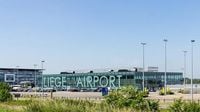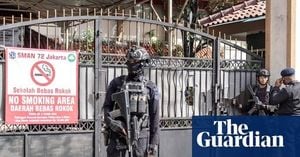Flights at some of Europe’s busiest airports ground to a halt this week as a wave of mysterious drone sightings sent security officials scrambling and left thousands of passengers stranded. The disruptions, which rippled from Belgium to Sweden, have prompted urgent questions about the vulnerability of critical infrastructure and the specter of foreign interference—particularly as tensions with Russia remain high across the continent.
It all began late Tuesday, November 4, 2025, when suspected drones were spotted near both Brussels Airport—the main international gateway to Belgium—and Liege Airport, a major European cargo hub. According to the Associated Press, these sightings forced the immediate suspension of both arrivals and departures, resulting in dozens of canceled flights. The chaos at Brussels left some 400 to 500 passengers to spend the night at the airport, as confirmed by airport spokeswoman Ariane Goossens to AFP.
Christian Delcourt, the head of communications at Liege Airport, described the incidents as deeply troubling for national security. Flights at Liege resumed only in the early hours of Wednesday after a six-hour hiatus, Delcourt told reporters. The disruption didn’t end there: on Thursday night, more drones were seen over Liege, leading to further interruptions between 9 p.m. and 1 a.m., and again on Friday morning between 7 a.m. and 8 a.m., before full operations resumed.
The country’s air traffic control service, Skeyes, emphasized the seriousness of each report. "We have to take every report seriously," spokesperson Kurt Verwilligen said, after a drone sighting at Liege on Friday morning forced a 30-minute closure. Flights resumed shortly after, but the pattern was clear: Belgium was facing a sustained and coordinated challenge to its airspace security.
Meanwhile, similar scenes were unfolding elsewhere in Europe. On Thursday evening, Gothenburg-Landvetter Airport—Sweden’s second largest—was forced to halt flights after one or more drones were spotted over airport grounds, as confirmed by Reuters. The Swedish Civil Aviation Authority closed the airspace, suspending all flights until 9 p.m. while police launched an investigation into suspected aviation sabotage. The operator, Swedavia, said the closure was necessary to ensure safety as authorities worked to verify the threat.
This isn’t the first time Europe has faced such disruptions. In September 2025 alone, airports in Denmark and Norway were forced to suspend operations due to drone sightings. Copenhagen’s Kastrup and Oslo’s Gardermoen—two of Scandinavia’s largest airports—were among those affected, redirecting dozens of flights. In Poland, the military shot down Russian drones that breached its airspace for the first time, while Romania scrambled F-16s to intercept a Shahed drone over the Danube. Even France reported unknown drones over a military base where Ukrainian troops had trained, underscoring the cross-border nature of the threat.
Back in Belgium, the stakes are particularly high. Over the weekend before the airport disruptions, authorities reported drone activity over the Kleine-Brogel military base, where a number of U.S. nuclear weapons are believed to be stored. More drones were seen near the base on Tuesday and Wednesday evenings, though officials have been tight-lipped about the specifics. NATO declined to comment on whether drones had been spotted near its headquarters in Brussels, its military HQ in Mons, or other alliance-linked facilities across Belgium.
Amid mounting concern, Prime Minister Bart De Wever convened an emergency meeting of key government ministers and security chiefs on Thursday, November 6, 2025. Defense Minister Theo Francken, speaking after the meeting, announced that Belgium would have its National Air Safety Center at Beauvechain air base fully operational by January 1, 2026. "This center will ensure better monitoring and protection of Belgian airspace, and prepare Belgium for future challenges in air safety," Francken stated on social media. The decision, he explained, was taken to address what he described as a coordinated attack. Francken further suggested that the incidents “could not have been done by amateurs,” calling them part of “a spying operation.”
Interior Minister Bernard Quintin echoed the urgency, writing on X (formerly Twitter), "The recurrence of drone-related incidents directly affects the security of our country. We must act in a calm, serious and coordinated manner." Quintin confirmed that investigations were underway to determine how many drones were involved and who was responsible. The Belgian government’s emergency national security council meeting on Thursday underscored just how seriously officials are taking the threat.
While no official attribution has been made, suspicion has swirled around Russia, especially as the war in Ukraine grinds through its fourth year. Some Western officials have labeled these incidents as a form of "hybrid warfare," designed to destabilize and sow panic. Moscow, for its part, has denied any involvement. Nevertheless, the pattern of drone sightings—often near sensitive military sites or critical infrastructure—has fueled speculation about state-sponsored espionage or sabotage.
"They are trying to sow panic in Belgium," Defense Minister Francken told local media, describing the events as an act of destabilization. The sentiment is shared by many across the continent, as similar drone-related incidents have targeted airports and military locations in Germany, Denmark, and beyond. The timing is particularly sensitive: Belgium is home not only to NATO and EU headquarters but also Europe’s largest financial clearinghouse, which holds tens of billions of euros in frozen Russian assets. The fate of those assets is a hot topic, with EU leaders set to discuss their potential use as collateral for loans to Ukraine at a summit in Brussels next month. Prime Minister De Wever has already warned that Russia might retaliate if the assets are confiscated.
The broader European context only adds to the sense of urgency. In late September, Russian military aircraft conducted provocative maneuvers near the airspace of NATO’s Baltic members, prompting Hungary’s fighters based in Lithuania to intercept a group of five Russian jets. Estonia, after experiencing repeated airspace violations by Russian MiG-31s, initiated consultations with NATO allies under Article 4 of the North Atlantic Treaty for the first time, signaling the seriousness with which such threats are now viewed.
For ordinary travelers, the immediate impact is all too clear: missed connections, nights spent in airport terminals, and a growing sense of unease about the safety of Europe’s skies. For governments and security agencies, the challenge is even greater. As drone technology becomes ever more accessible and sophisticated, distinguishing between amateur mischief and coordinated attacks grows harder by the day. The recent incidents have made it clear that Europe’s airspace is more vulnerable than many had realized—and that adversaries, whoever they may be, are willing to exploit those vulnerabilities.
The coming months will likely see intensified efforts to bolster airspace monitoring and protection, not just in Belgium but across the continent. With new security centers coming online, and governments pledging coordinated action, officials hope to stay one step ahead. Whether those efforts will be enough to deter future incursions—or to identify those responsible for this latest wave of drone disruptions—remains to be seen. For now, the skies over Europe are being watched more closely than ever before.






